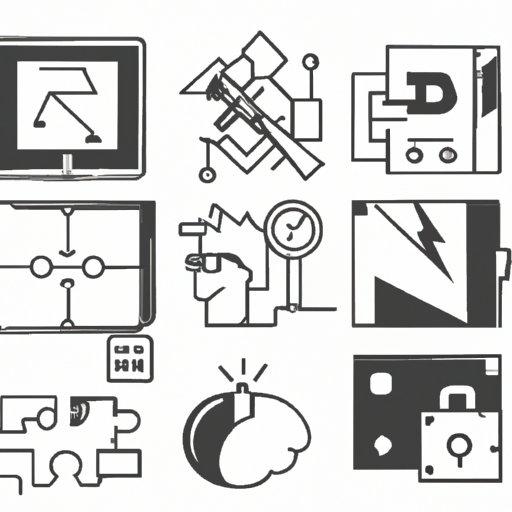
Introduction
Do you have a unique idea for a game that you want to bring to life? The world of game development can be intimidating, but with the right tools and guidance, anyone can create their own game. In this guide, we will cover all aspects of game development, from the ideation process to launching and marketing your game. Whether you are a beginner or an experienced developer, this article will provide you with actionable steps and tips to bring your game to life.
7 Steps to Creating Your Own Game: From Concept to Finished Product
Step 1: Idea Generation
The first step in creating your own game is to come up with an idea. Your game should have a clear concept that sets it apart from existing games and appeals to a specific audience. Brainstorm different ideas and consider what makes your game unique. Once you have a few ideas, narrow them down by considering the feasibility of each one and the resources you have available.
Step 2: Defining Game Mechanics and Rules
Once you have your idea, you need to define the game mechanics and rules. Your game mechanics are the rules and actions that define how your game is played. Consider what kinds of actions the player will be able to take, how these actions will affect the game world, and how players will interact with each other. Your game’s rules should be clear and easy to understand, with consistent consequences for actions.
Step 3: Creating a Storyboard
Before you start developing your game, create a storyboard. A storyboard is a visual representation of your game that outlines the gameplay and story. Consider the game mechanics and rules you defined in the previous step and visualize how they will play out in the game world. If your game includes a storyline, sketch out the key events and plot points.
Step 4: Developing a Prototype
Once you have your storyboard, it’s time to start developing a prototype. A prototype is a basic version of your game that allows you to test your game mechanics and get feedback from others. Your prototype doesn’t need to be polished or complete, but it should be functional enough for people to play.
Step 5: Playtesting and User Feedback
Playtesting your game is crucial for identifying and fixing any issues with your game mechanics, rules, and gameplay. Give your prototype to others to play, and ask for feedback. Take note of what worked well and what needs improvement, and iterate on your game accordingly.
Step 6: Polishing the Game
Once you have received feedback from playtesting, it’s time to polish your game. This includes refining the game mechanics, improving the gameplay, and adding any necessary features. Ensure that your game is well balanced, with a good difficulty curve and clear instructions for players.
Step 7: Launching and Promoting the Game
Your game is complete, polished, and ready to launch. The final step is to put your game out into the world and promote it. Consider your target audience and use appropriate marketing channels to reach them. Share your game on social media and gaming communities, create a website, and attend gaming events to showcase your game.
The Art of Game Development: Tips and Tricks for Beginners
Understanding the Basics of Game Development
Game development involves the creation of video games or non-digital games. In digital game development, coding serves as the foundation of the game, while non-digital games can be created with physical components like cards and boards.
Tips for Designing Game Mechanics
The mechanics of your game are what make it unique. Make sure that your mechanics are easy to grasp and intuitive. Consider how different mechanics interact with each other to create challenging gameplay.
Game Design Principles to Keep in Mind
Balancing gameplay is essential for keeping players engaged and preventing boredom. Consider pacing, scaling difficulty, and the balance between exploration and storytelling when designing a game.
Key Differences Between Developing Digital and Non-Digital Games
Non-digital games can be developed and playtested much more quickly than digital games. However, digital games can offer limitless possibilities for customization and player interactions.
Learning to Code Your Game: A Simple Guide to Getting Started
Overview of Different Game Engines
Game engines are software frameworks designed to make it easier to create and develop games. Some popular game engines include Unity, Unreal Engine, and Godot.
Steps for Coding a Game
Coding a game involves creating a playable game with programming languages like C++, Python, or JavaScript. Your game engine will provide you with the tools and resources necessary to code your game.
Tips for Debugging and Testing
Debugging and testing your game is critical for identifying and fixing any issues. Use software debugging tools like Unity’s Visual Studio Debugger, and get feedback from others to improve your game.
The Importance of Prototyping: Creating a Successful Game from Scratch
Why Developing a Prototype is Crucial for Game Creators
Developing a prototype is the best way to get feedback on your game and identify any issues early on. Prototypes can be developed quickly and cheaply, making them an excellent tool for game creators.
Steps for Creating a Successful Prototype
When creating a prototype, focus on the core mechanics of your game. Keep it simple and easy to play, and be open to feedback and iteration.
Examples of Successful Game Prototypes
Many popular games, including Minecraft, started as successful prototypes. Creating a prototype is an important step in the game development process, and can ultimately lead to a successful and popular game.
Designing Your Game: A Comprehensive Guide to Gameplay and Mechanics
Key Elements to Consider When Designing a Game
When designing a game, consider the setting, characters, mechanics, balance, and pacing. These elements all contribute to the player’s experience of the game.
Tips for Balancing Gameplay
Balancing gameplay is critical for creating a challenging and enjoyable game. Create a range of difficulty levels, offer rewards for completing tasks, and take player feedback into account.
How to Create Engaging and Challenging Mechanics
Engaging and challenging mechanics are essential for creating a game that draws players in. Consider mechanics that are easy to understand but difficult to master, and offer variety and depth to keep players engaged.

Marketing Your Game: Tips to Help Your Game Gain Exposure and Succeed
Understanding Your Target Audience
Before you start marketing your game, it’s important to understand your target audience. Consider their demographics, interests, and preferences to create a marketing strategy that will reach and engage them.
Creating a Marketing Plan
A marketing plan is crucial for promoting your game effectively. Consider different promotional channels, such as social media, influencer marketing, and events, and create a timeline for when and how you will promote your game.
Using Social Media and Other Channels Effectively
Social media is a powerful tool for promoting your game. Create engaging content, use relevant hashtags, and engage with your followers to build a community around your game.
Finishing Touches: Sound Design, Graphics, and Final Production Steps for a Polished Game
The Role of Sound Design in Gaming
Sound design is critical for creating an immersive gaming experience. Use sound effects and music to enhance gameplay and emotions.
Tips for Creating Engaging Graphics
Engaging graphics are essential for creating a visually appealing game. Use colors, shapes, and textures to create a unique look for your game and consider user interface design.
Final Production Steps for a Polished Game
Before launching your game, make sure that all final production steps are complete. Test for bugs, polish the gameplay and graphics, and ensure that the game runs smoothly on all devices.
Conclusion
Creating your own game can be a challenging and rewarding experience. By following the steps and tips outlined here, you can bring your game to life and create a successful and enjoyable game for players to enjoy. Remember to stay consistent and persistent, and don’t be afraid to ask for feedback and input from others.




